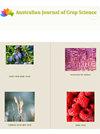Impact of phytopathogens on seed quality of tropical grasses in integrated systems
Q3 Agricultural and Biological Sciences
引用次数: 0
Abstract
This study aimed to identify the main fungal and phytonematode genotypes associated with the main tropical forage seeds used in integrated systems and to distinguish seeds with high physiological and sanitary quality, for which two experiments were conducted. In year 1 (2017/18 crop year), the first experiment (experiment 1) was conducted with seeds produced in the 2017/18 crop year, in a randomized open design with four configurations and four replications. In year 2 (2018/19 crop year), the study (experiment 2) was replicated with the experimental conditions of the first experiment (randomized automatic design, with four sessions and four replications), but using samples from the 2018/19 crop year. The seeds were produced in the 2017/18 and 2018/19 crop years, with the same origin, and were purchased within commercial packages. The treatments of experiments 1 and 2 were the same and consisted of seeds of Brachiaria ruziziensis and the Brachiaria brizantha cultivars Marandu, Xaraés, and BRS Piatã. The same variables were evaluated for each experiment: water content, physical purity, viability, germination rate index, first germination count, germination percentage, crop value, dormancy, accelerated aging, and incidence of fungi and phytonematodes. Cladosporium sp., Fusarium sp., Rhizoctonia sp., Meloidogyne sp., Filenchus sp., Aphelenchus sp., Aphelencoides sp., and Rotylenchulus sp. are the main phytopathogens associated with seeds of the main tropical forage species used in integrated systems. The seeds of B. ruziziensis present high physiological quality, whereas the seeds of the B. brizantha cultivar Xaraés grass present high sanitary quality.植物病原菌对综合系统热带禾本科种子品质的影响
本研究旨在鉴定用于综合系统的主要热带牧草种子的主要真菌和植物线虫基因型,并区分生理和卫生品质高的种子,为此进行了两项实验。在第1年(2017/18作物年),以2017/18作物年生产的种子进行第1个试验(试验1),采用随机开放设计,4个配置,4个重复。在第二年(2018/19作物年),研究(实验2)在第一次试验(随机自动设计,四次,四个重复)的实验条件下重复,但使用2018/19作物年的样本。这些种子是在2017/18和2018/19作物年度生产的,来源相同,并以商业包装购买。试验1和试验2处理方法相同,均为Brachiaria ruziziensis种子和Brachiaria brizantha品种Marandu、xara和BRS Piatã种子。对每个试验评估相同的变量:含水量、物理纯度、活力、发芽率指数、首次发芽数、发芽率、作物价值、休眠、加速老化、真菌和植物线虫的发生率。Cladosporium sp.、Fusarium sp.、Rhizoctonia sp.、Meloidogyne sp.、Filenchus sp.、Aphelenchus sp.、Aphelencoides sp.和Rotylenchulus sp.是综合系统中主要热带牧草种子相关的主要植物病原体。白刺草的种子具有较高的生理品质,而白刺草的种子具有较高的卫生品质。
本文章由计算机程序翻译,如有差异,请以英文原文为准。
求助全文
约1分钟内获得全文
求助全文
来源期刊

Australian Journal of Crop Science
农林科学-农艺学
CiteScore
1.20
自引率
0.00%
发文量
75
审稿时长
3.5 months
期刊介绍:
Information not localized
 求助内容:
求助内容: 应助结果提醒方式:
应助结果提醒方式:


